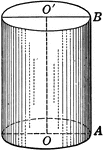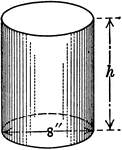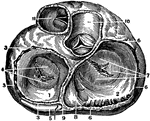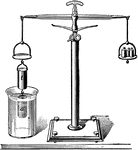
Archimedes Principle
"From on pan suspend a hollow cylinder of metal t, and below that a solid cylinder a of the same size…
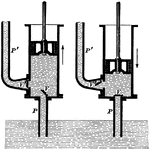
Forcing Pump
"As the piston ascends, as shown in the left-hand figure, the pressure of the atmosphere forces the…
!["A double-acting pump of the piston pattern is shown [here]. Such a pump has two sets of suction valves and delivery valves, one set for each side of the piston. With the piston moving in the direction of the arrow, the pressure of the atmosphere forces the water up the suction pipe P into the left-hand end of the pump cylinder, the left-hand suction valve opens and the left-hand delivery valve is closed...The water now flows up the delivery pipe P'." —Hallock 1905](https://etc.usf.edu/clipart/36100/36170/2act_fpump_36170_mth.gif)
Double-acting Force Pump
"A double-acting pump of the piston pattern is shown [here]. Such a pump has two sets of suction valves…
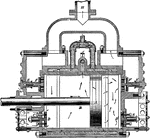
Air Compressor
"For many purposes compressed air is preferable to steam or other gas for use as a motive power. In…
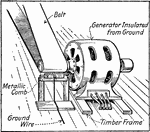
Using a Grounded Metallic Comb to Reduce Static Charge, Perspective View
"Method of using a grounded metallic comb near the driving belt to relieve the belt of static charges."…
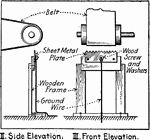
Using a Grounded Metallic Comb to Reduce Static Charge, Front and Side View
"Method of using a grounded metallic comb near the driving belt to relieve the belt of static charges."…

Heart
Front view of the heart and great vessels. The pulmonary artery has been cut short close to its origin.…

Lungs and Air Passages
The lungs and air passages seen from the front. On the left of the figure the pulmonary tissue has been…

Compressibility of Air
"Let P be a piston, fitted, air-tight, to the cylinder AB. As the piston is driven down, the air, unable…
Screw
"Cylinder with a spiral of winding parallel ridges called Threads. If the Threads were unwound from…
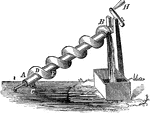
Archimedes' Screw
"Invented to raise water. A hollow tube wound spirally around a solid cylinder. As the cylinder is turned,…

Angle of Incidence and Reflection
"Mirror A/B is only half of person C's height. C is able to view his entire body through such a small…

Cylinder Inscribed in Pentagonal Prism
Right circular cylinder inscribed in a pentagonal prism. Or, Pentagonal prism circumscribed about a…
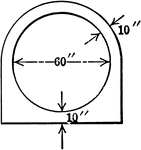
Cross Section of Concrete Conduit
Cross section of concrete conduit. The diagram can be used to find volume.
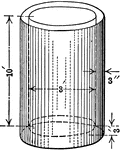
Cylindrical Water Tank
Cylindrical water tank with a height of 10 ft., thickness of 3 inches, and diameter of 3 feet. The diagram…
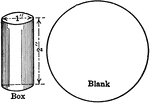
Cylindrical Box - Blank
Sheet metal blank for making a cylindrical box with a diameter of 1 inch and a height of 2 inches.
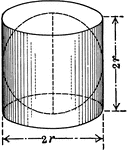
Sphere Inside of Cylinder.
An illustration of a sphere inside of a cylinder with radius/diameter labeled. Illustration for showing…
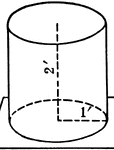
Right Circular Cylinder With 1 ft. Radius and 2 ft. height.
Right circular cylinder with a radius of 1 foot and a height/altitude of 2 feet.
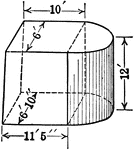
Composite Figure of Quadrilateral Frustum With Half of a Cylinder Attached
An illustration of a composite figure made up of a quadrilateral frustum and half of a cylinder. Frustum…
Survey of Lake Front in Chicago
Illustration showing a survey on the lake front in Chicago with distances and angle measures shown.
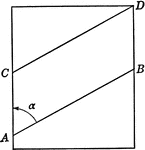
Spiral Drawn on Piece of Paper Shown Flat
Spiral with lines AB and CD drawn on piece of paper shown flat.

Spiral Drawn on Piece of Paper and Rolled
Spiral with lines AB and CD drawn on piece of paper and rolled into a cylinder to form spiral running…
Spinal Cord
Diagrammatic view from before of the spinal cord and medulla oblongata, including the roots of the spinal…
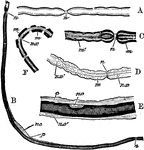
Nerve Fibers
To illustrate the structure of nerve fibers. Labels: A, nerve fiber examined fresh; n, node. B, nerve…
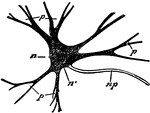
Nerve Cell
A large nerve cell from the ventral horn of the spinal cord. Labels: n, nucleus; n', small body, called…
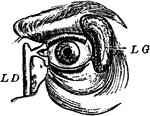
Eye and Lachrymal Gland
Front view of left eye, with eyelid partly removed to show lachrymal gland (tear-producing gland), and…
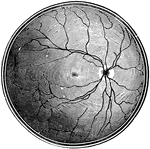
Retina Blind Spot
The right retina as it would be seen if the front part of the eyeball with the lens and vitreous humor…

Larynx
The larynx viewed from its pharyngeal opening. The back wall of the pharynx has been divided and its…

Muscles on the Front of the Arm and Forearm
Superficial muscles on the front of the arm and forearm.
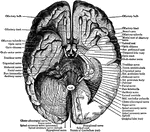
Under Surface of the Brain
View of the under surface of the brain, with the lower portion of the temporal and occipital lobes,…
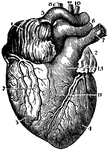
Anterior View of the Heart
An anterior view of the heart in a vertical position with its vessels injected.
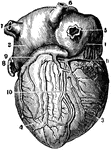
Posterior View of the Heart
A posterior view of the heart in a vertical position and with its vessels injected.
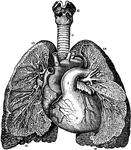
Relative Position of the Heart and Lungs
A view of the bronchia and blood vessels of the lungs, as shown by dissection, as well as the relative…
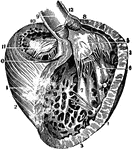
Left Ventricle of the Heart
A three-quarter view of the left ventricle after removal of its anterior parietes.
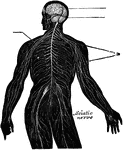
The Nervous System
View of the nervous system of man, showing the nerve centers (brain and spinal cord) giving off nerves…
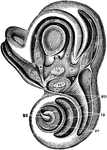
Bony Labyrinth of the Inner Ear
A highly magnified view of the external face of the bony labyrinth of the left side, opened so as to…
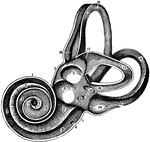
The Labyrinth of the Inner Ear
A view of the labyrinth of the left side laid open in its whole extend, so as to show its structure…
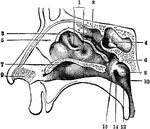
The Nasal Fossae
The nasal fossae (cavum nasi) are two irregular cavities in the middle of the face, separated by the…
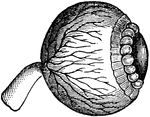
Lens of the Eye
The crystalline lens, which is a bi-convex, elastic, transparent body, enclosed in a capsule, held in…
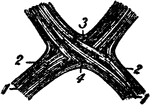
The Optic Chiasma
The optic chiasma or commissure, which is seen at the base of the brain in front of the tuber cinereum…

The Pharynx
The structure of the pharynx, a conical, musculo-membranous tube that forms the alimentary canal which…

The Pancreas
The pancreas, a compound racemose gland about 5.5 inches long and 1.5 inches wide, situated transversely…

The Spleen
The spleen, a soft, brittle, highly vascular organ, of dark purplish color, in size about 5 x 3 x 1.5…
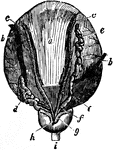
The Bladder
The bladder, a reservoir for urine, is a musculo-membranous sac, situated n the anterior portion of…



